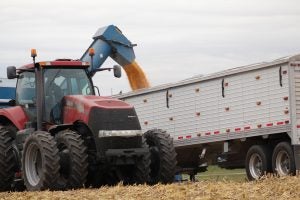Wisconsin-based Rock River Laboratory urges growers to consider the fertilizer source, application rate, and the timing of application when managing for extra bushels at harvest. But, with a few helpful tools, growers can take some of the guesswork out of crop production.
“Analysis is a great way to know what baseline nutrients are available for production, rather than hoping the fields are holding enough fertility to make a crop,” explains Scott Fleming, Rock River Laboratory nutrient management specialist. “The most effective analyses include soil testing, plant tissue analysis, and nitrate testing.”

Each of the tests Fleming mentions offers a measurement of how much nutrient a plant has available to convert into yield. To utilize these tools, Fleming recommends four steps for growers and their consultants to work through in order to gain that extra yield.
Establish a baseline
The first step for growing a high yielding crop is to determine the nutrient content of the soil. “Soil is the medium for all plant growth,” says Fleming. “So, soil tests are a great way for growers to determine what to adjust in order to set a strong foundation for high yield.”
Basic soil tests vary by region, but most include the soil’s acidity (pH), organic matter (OM), phosphorus (P), and potassium (K). Fleming also recommends looking for a lab that can provide Calcium (Ca) and Magnesium (Mg), and Cation Exchange Capacity (CEC) (Ca and Mg elements calculate CEC) components in the soil analysis.
“The CEC is a measurement of the soil’s ability to hold nutrients. CEC levels will dictate how much fertilizer to apply in one application,” shares Fleming. CEC can also help provide insight into a soil’s resistance to pH changes according to Fleming.
Determine nutrient movement
Fleming likens the scope of soil and plant fertility to driving a vehicle. “Soil tests are a great indicator of what is in a field’s ‘nutrient gas tank’,” says Fleming. “We can establish that there is a full tank of phosphorus and potassium. The problem is that the fuel gauge only provides a limited amount of information.”
Fleming explains the second step for finding extra bushels is looking at the ‘nutrient speedometer’, or a plant tissue analysis, to gather more movement information. “Plant tissue analysis reports have many different formats but they all explain the same thing,” explains Fleming. “They provide a picture of how much of each nutrient was in a plant on a given day.”
Plant tissue analysis reports are generally laid out in a bar or radial graph and compared to known sufficiency ranges. The sources of these sufficiency ranges vary, but they are generally based on proprietary or university recommendations. A pair of powerful options exist when using plant tissue analysis to find the top end bushels. The most common way is identifying a hidden hunger. “A hidden hunger is a nutrient deficiency that hasn’t become a visual symptom,” says Fleming. “Growers and their consultants should work to identify these hungers before the damage of visual nutrient deficiencies are displayed.”
Growers can also use tissue analysis to troubleshoot problem areas. Fleming suggests growers pull tissue samples from the good areas of the crop to then compare and contrast the results with that of a sample from the bad area of the crop, which in turn will help growers determine the cause for poor plant performance.
Analyze nitrates
The third step and analysis tool to help growers achieve the most from each unit of nitrogen applied is nitrate analysis. Samples can be pulled for nitrate analysis prior to planting or prior to side dressing. The Pre-Plant Nitrate Test (PPNT) requires pulling soil samples at 0-12” depth and 12-24” depth.
“These samples are analyzed separately for their nitrate content, determining the total amount of nitrogen carried over from the year prior,” says Fleming. Growers can adjust their rates based on this carryover determination. “A grower’s nitrogen application rates can also be fine-tuned after planting by using the Pre-Sidedress Nitrate or ‘PSNT’ test,” explains Fleming. “The samples for this test are pulled to a twelve-inch depth after planting and prior to side dressing.”
The results will quantify how much nitrate is in the soil. A table that relates nitrate levels to application rates is then used to determine application rates.
Call on outside resources
Quality analyses are one way to assess and establish crop needs for optimum performance. However, an analysis loses some value without the complementary boots on the ground to collect and interpret the results.
“Growers are the first line of caretakers when shooting for the next bushel,” says Fleming. “They are the key to performing quality work and inside knowledge. And in today’s complex world of crop production, a grower is never alone.”
He explains that analysis interpretations and guidance for growers can come in countless forms. University and extension, ag retailers, seed consultants, peer groups, and web applications are just a handful of the resources available in today’s information age. “A grower should count on a few of these resources to get an outside perspective and expert insights on their crop management scheme,” suggests Fleming.


